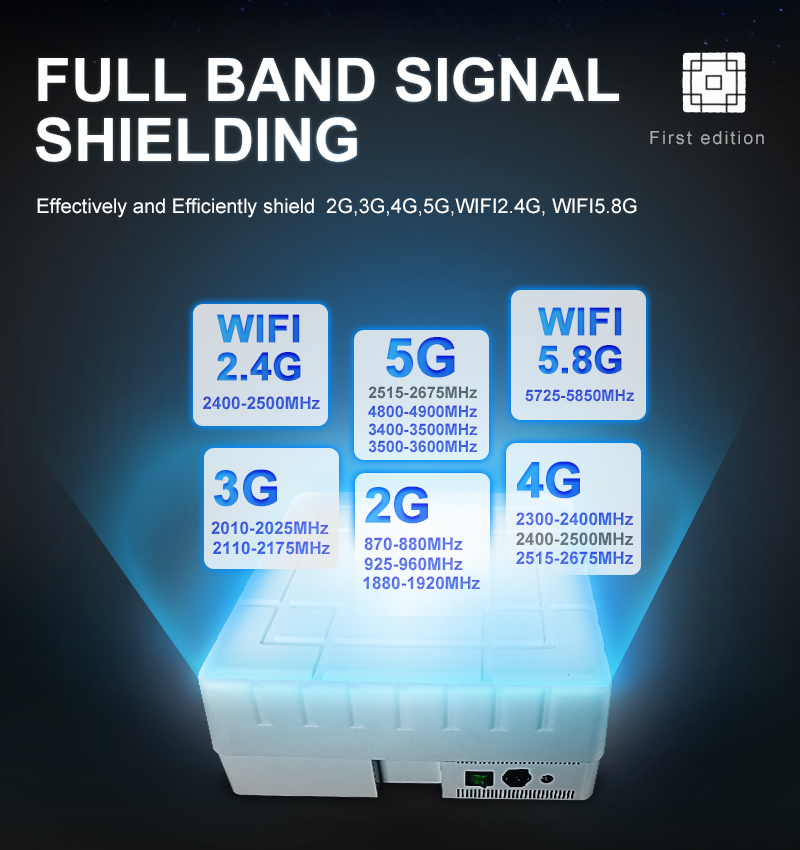1. Mobile phone detection technology
The mobile phone detection technology mainly detects when the electromagnetic wave signal emitted by the mobile phone when the mobile phone is working causes the electromagnetic power in the area where the mobile phone is located to increase to a set value, thereby determining that the mobile phone is working. The technology is very advanced at first glance, and in fact it is only a very superficial understanding. When the technology was proposed, the following issues were not considered:
1. Uncertainty of mobile phone transmit power
The specific base station through which the mobile phone enters the network when it is working is determined by the traffic volume of the surrounding base stations and the dynamic deployment. When the mobile phone is used for logging in, if the nearby base station is busy, it will log in to the far idle base station to work. The transmission power of the mobile phone will be adjusted according to the link loss of the radio wave from the mobile phone to the base station. Usually the mobile phone receives the base station If the signal is strong, the transmit power is weak.
2. The distance between the mobile phone and the detector (link loss) is uncertain
The distance between the mobile phone and the detector and the presence or absence of obstructions will affect the strength of the signal received by the detector.
3. Uncertain spatial electromagnetic interference intensity
Common lightning, fluorescent lamps, and electronic devices are all sources of interference. At the same time, the out-of-band strays of mobile phones are very large. Although the detector is used in the SAW filter on the mobile phone, the out-of-band suppression of the filter is not enough, and it is easy to produce cross-frequency phenomenon. When used for detection, it cannot effectively filter out other interference signals, making the detection system in chaos.
4. The sensitivity of the detector is uncertain
Generally, the sensitivity setting of the detector does not have a specific quantitative value. When debugging, dial the mobile phone by constantly adjusting the position, and observe whether the detector detects the arrival and adjust the sensitivity.

5. 3G signal detection is more difficult
Because 3G technology uses advanced technologies such as code division, spread spectrum and time division, and is often submerged in environmental noise, its transmission power is smaller. Especially in the time division technology of mobile 3G, the mobile phone transmit and receive signals are in the same frequency band, separated by time. If it is in an area with a strong TD signal, the detected downlink signal strength exceeds the signal strength sent by the mobile phone, and it will be difficult to detect and distinguish. .
Therefore, the shielding system using detection technology is mainly manifested as false positives and false negatives, which are extremely serious and cannot achieve practical purposes.
2. Mobile phone detection + shielding technology
The detector controls the switch of the shielding device, and immediately turns on the shielding device when it detects that the mobile phone is in use, hoping to achieve the purpose of immediate shielding. However, in actual operation, the reason why the shielding device cannot be activated immediately is that the signal jammer device mainly achieves the shielding effect by preventing the mobile phone from logging in to the network, and the base station sends the mobile phone login instruction to be issued intermittently. If the mobile phone has logged on to the network, especially It is already called, and the mobile phone can still talk normally during the period when the base station does not send the mobile phone to change the original login instruction. This phenomenon is more obvious in China Unicom's 3G and WCDMA networks. Unless the shielding power can far exceed tens or even hundreds of times that of conventional shielding equipment, the effect of interrupting mobile phone communication can be achieved immediately. Such power is not only difficult to achieve in terms of technology and cost, but its radiation is strong and unsafe.
3. Current application status of detection + shielding technology
This technology seems to be superior in terms of application principles, and is especially favored and respected by users in the southeast and northeast regions of my country. In fact, no successful cases have appeared so far, and it has caused considerable misleading in the industry and brought to the entire industry. Not a small adverse effect.
If cavity filtering and code stream analysis are used, the above shortcomings can basically be solved, but because its cost is too high, it is difficult to be accepted by users and loses market significance.
